Tech File: Shaft Generators 101 – What are They?

Yaskawa Environmental Energy / The Switch shines a light on how to produce electricity efficiently on ships.A ship is like a floating city that needs electricity to power its operations and amenities on board. So how to generate that electricity while being mobile? That question has been challenging the shipping industry for more than 150 years, when exciting new technologies were being pioneered at the forefront of the new age of electricity. Fast forward to today, and the challenges surrounding the production of electricity on board vessels have been spurred again.
Yaskawa, Corvus Team Up to Develop Short-Circuit Limiter for Maritime Battery Packs
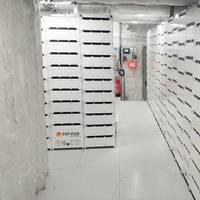
Finland-based power electronics specialist Yaskawa Environmental Energy/The Switch is partnering up with maritime energy storage system (ESS) manufacturer Corvus Energy to continue the development of its smart Battery Short-Circuit Limiter (BSCL) protection device for large-scale battery solutions and advanced DC power distribution.Under the three-year memorandum of understanding (MoU), Corvus Energy becomes the preferred partner for Yaskawa Environmental Energy / The Switch in the ongoing development of the.According to the companies…
NYK VLCC Tateshina Designed to Be 23% More Energy Efficient
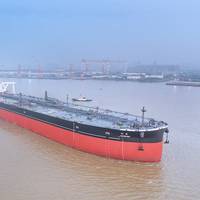
The very large crude oil carrier (VLCC) Tateshina, owned by NYK, was delivered on November 8, 2021, built at Nantong COSCO KHI Engineering Co., Ltd. (NACKS) in China.According to the owner, several enhancements have been incorporated on Tateshina to help improve performance and fuel efficiency and reduce emissions, including a modified bow shape to help reduce wave resistance. This ship is also equipped low-friction paint, high-efficiency large-diameter propellers, and ladder fins that regulate the water flow at the stern and reduce energy loss.
LNG Only Fills Niches in Europe
Although LNG (Liquid Natural Gas) provides a solid supplement to European gas supplies, the EU is and will remain a pipeline market – for good reasons, said Wintershall's new position paper.The report from Germany's largest crude oil and natural gas producer on the importance of liquid gas for Europe said that the liquefaction is highly energy-intensive – the energy consumption corresponds to about 13% of the gas transported.With an energy loss of less than five percent, pipelines are much more energy-efficient. Another argument for pipeline gas lay in its lower costs. Russian pipeline gas, for example, is more competitive and less expensive than LNG from the USA.Since the EU's own gas production is declining, Wintershall welcomes any additional import route.
Hull Vane Retrofit Improves OPV’s Performance
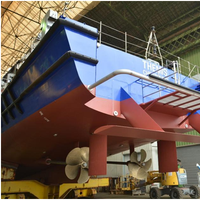
CMN Shipyard in Cherbourg, France, conducted sea trials on the June 13, 2018 on the OPV Thémis from the French Coastguard (Affaires Maritimes).The patrol vessel received a hydrodynamic upgrade at the shipyard by retrofitting the patented Hull Vane, an underwater wing which reduces the ship’s resistance. Comparison with the benchmark sea trials – conducted in January in exactly the same conditions – by CMN’s sea trial team showed a reduction in fuel consumption of 18 percent at 12 knots, 27 percent at 15 knots and 22 percent at 20 knots.
Rolls-Royce Launches Energy Management System

Rolls-Royce has launched the next generation of its Energy Management (EM) System. The system will allow customers to reduce energy usage, fuel consumption and operating costs whilst supporting environmental compliance and providing performance information that enables the ship to comply with SEEMP rules and IMO regulations. The Energy Management System offers customers a more data-driven performance management and decision making approach. This will give an enhanced ability to monitor the performance of an individual vessel or a fleet.
New Plan Pledges Ferry Safety Lead
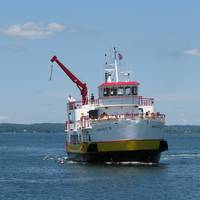
Interferry has unveiled a strategic plan promising to put safety issues at the heart of its work as the voice of the worldwide ferry industry. The pledge came at the global trade association’s 41st annual conference in Manila – a venue chosen to spotlight the challenges of domestic ferry safety in developing nations. According to Interferry, the plan signals its overriding ambition to help lift ferry safety in all parts of the world to the very high standard already in place in North America and Europe, where casualties in recent decades have been extremely rare.
ABB Debuts New Azipod Propulsion Model
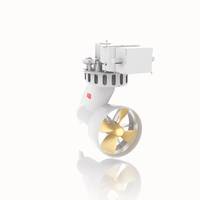
ABB’s newly launched Azipod propulsion unit is said to be up to 10 percent more efficient than previous versions. ABB hopes to expand the appeal of the podded electric propulsion system beyond established markets with its improved efficiency and bollard pull. According to ABB, the new linear flow Azipod XL achieves this jump in efficiency by introducing a nozzle with stator plates, which directs the water flow from the propeller to reduce the turbulence and energy loss and to give the optimum thrust for the vessel.
Russian Military Muscling into the Arctic
Russia has built a giant military base in the far northern Arctic where 150 soldiers can live autonomously for up to 18 months, AFP quotes the Defence Ministry as saying. The building erected on the large island of Alexandra Land, which is part of the Franz Josef Land archipelago, is 97 percent complete. The "Arctic Trefoil" compound, located on 80th parallel north has been built using the latest technologies to prevent energy loss. The construction teams have paved the roads on the remote island and the main building is 97 percent complete, according to the officials. The soldiers can move around the base from one building to another without going outside to face winter temperatures which can reach minus 47 degrees Celsius (-57 degrees Fahrenheit). Fuel can be pumped in from tankers.
Eniram Launches 3 New Energy Savers
Eniram Ltd, a provider of energy management and fuel-saving technology and analytic services to the shipping industry, announced the release of three new products aiming to help save fuel and optimize energy usage on vessels. The company has launched the upgraded speed optimization solution Eniram Speed 3.0, Eniram Performance 3.0 data analytic software, as well as Eniram Fleet Route KPIs designed to support improved routing. Improving on past version Eniram Speed 2.0, the new Eniram Speed 3.0 takes into account factors such as the prevailing sea state, in computing and recommending best speed profile to consume least energy and thus save fuel.
MHI Debuts Non-ozone-depleting Refrigerant
Mitsubishi Heavy Industries, Ltd. (MHI) has developed a new series of centrifugal chillers, dubbed the "ETI-Z Series," adopting a new refrigerant, HFO-1233zd(E), that offers outstanding environmental compatibility. The various models in the new series will be progressively launched starting this September. The ETI-Z series marks the world's first small-size centrifugal chillers to adopt the new refrigerant. The ETI-Z Series carries on the fundamental product concept of the ETI Series: high performance combined with compact size. The ETI series with built-in inverter panel have been widely spread in to the market since the first models were introduced in 2008. Models in the new ETI-Z Series have a cooling capacity within a range of 80 to 700 refrigeration tons*1 (RT).
Next Gen Tankers Delivered to Concordia Maritime
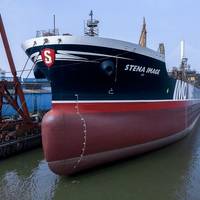
Concordia Maritime’s first chemical and product tanker based on the IMOIIMAX concept, the Stena Image, was delivered from the Chinese shipyard GSI (Guangzhou Shipbuilding International) in Guangzhou. The vessel, a 50,000 dwt MR tanker, is equipped with 18 tanks of the same size, each with a capacity of 3,000 m3, able to load vegetable oils and chemicals as well as petroleum products. The technical design has enabled fuel consumption, when sailing at service speed, to be reduced by 10-20% compared with other vessels of the same size.
IMOIIMAX Stena Impression named in Singapore
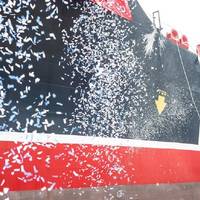
The first of Stena Bulk's $400M, ten-vessel order was named in Singapore yesterday. The Stena Impression is a IMOIIMAX 50,000 DWT MR chemical tanker owned by Stena Bulk and Indonesian's Golden Agri Resources (GAR). The ten ordered vessels will be operated by Stena Weco and will trade within the company’s logistical systems, which will include a fleet of more than 60 tankers. The IMOIIMAX tankers have been designed to transport both vegetable oils and chemicals, as well as clean and dirty petroleum products.
Great Ships of 2014: CSAV Tyndall
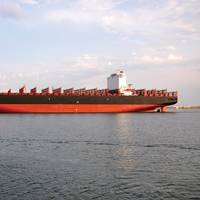
CSAV Tyndall is an 8600 TEU containership built by Daewoo Mangalia Heavy Industries (DMHI) and is part of a series of four containerships delivered to Zodiac Maritime Agencies Ltd. (UK) between 2013 and beginning of 2014. These projects are the biggest containerships ever built in the Black Sea and Mediterranean Sea area. The vessel measures 299.9 x 48.4 x 14.5 m and has a maximum speed more than 25 knots powered by a MAN B&W licensed main engine rated at 64,485 HP. The ship was built under the supervision of Lloyd’s Register and registered in Monrovia, Liberia.
Underwater PBCF Installation in South Korea
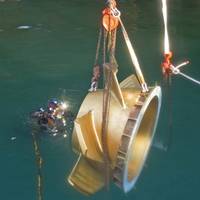
Last month Hydrex installed Propeller Boss Cap Fins (PBCF) on a 289-meter tanker during the vessel’s stop in Mokpo, South Korea. A Propeller Boss Cap Fins (PBCF) can recover energy loss of a propeller hub vortex in the propeller’s backward flow. This decreases fuel consumption by 5% when operating at the same speed, or boosts speed by 2% with the same fuel consumption. A clear explanation of the benefits of installing a PBCF can be found here. By performing the operation on-site and underwater, the tanker’s owner could immediately benefit from the system’s fuel savings.
Alaska Marine LInes Buys Energy Saving Refrigerated Units
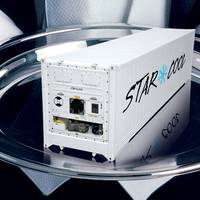
Alaska Marine Lines, a Lynden company providing marine transportation to and from Alaska, is continuing its efforts to work lean and green by purchasing 200 of the most energy efficient refrigerated units in the world. The Star Cool "reefers" achieve the industry's lowest energy consumption by matching the compressor speed to the required heat load of the container rather than running at a single constant speed. In addition, the box and refrigeration equipment are built as one unit with an insulation system designed to minimize energy loss.
Underwater PBCF Installations Bring Fuel Savings
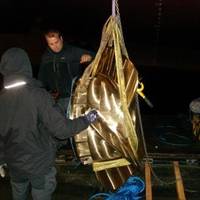
Last month Hydrex installed Propeller Boss Cap Fins (PBCF) on two tankers during their respective stops in Ghent and Antwerp. As a result of the underwater operation, the ships will not have to wait for their next drydock visit to start benefitting from the fuel savings the PBCF’s will bring them. The Propeller Boss Cap Fins (PBCF) is a device for propeller efficiency improvement developed by Mitsui O. S. K. Lines, Ltd. The PBCF can recover energy loss of a propeller hub vortex in the propeller’s backward flow.
Offshore Deep-water Drilling Conducters Installed by InterMoor
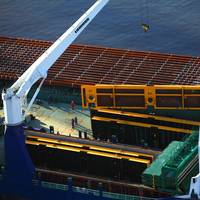
InterMoor, an Acteon company, completes installation of the drilling and production conductors for the Papa Terra offshoref Brazil. Petrobras serves as the operator of the Papa Terra concession with a 62.5 percent interest; Chevron holds the remaining 37.5 percent interest. InterMoor was responsible for the design, procurement, fabrication and installation of 15 conductors for the project. Fabricated at InterMoor’s 24-acre, Morgan City, La., facility, the conductors are 36 inches (91 centimeters) in diameter and 187 feet (57 meters) long.
Kittiwake Launches MHC Bearing Checker
London - Kittiwake, a global provider of asset control and protection technology, announced the launch of its MHC Bearing Checker, a small, hand-held device, designed to provide an instant indication of machinery condition. The acoustic emission-based instrument is a solution to monitoring an unlimited number of machines on a periodic basis. Based on the detection of high frequency activity which is naturally generated by deterioration in rotating machinery, the MHC Bearing Checker is simple to use as its Distress® parameter removes the need for machine specific interpretations. If Distress® is greater than 10, the user knows there is a problem and can instigate further checks.
Navy's Great Lakes Energy Project Moves Ahead
Naval Station (NAVSTA) Great Lakes and Naval Facilities Engineering Command (NAVFAC) Midwest are taking the next step toward decentralizing the base's steam heat delivery system, one of the largest energy efficiency initiatives in the 100-year history of the base. Teams of prospective project contractors and NAVFAC representatives will conduct site visits in mid-January at many of the buildings on base to be affected. As part of the bidding process, this will give the companies a better sense of what will be involved in the project, to be awarded by summer 2012. "This is one of the most significant projects undertaken within the region," said NAVFAC Midwest Commanding Officer Capt. Scott Bernotas. "Not only is the project large in scope, but also in future benefit.
Braemar Shipping Acquires Falconer Bryan Group
The Board of Braemar Shipping Services announced the acquisition of Falconer Bryan Pte Limited. Falconer Bryan provides a range of Survey, Engineering and Loss Adjusting services to the Marine and Energy Industries, including Loss Prevention surveys such as, towage and transport approvals, location approvals and location moves for mobile offshore drilling units, associated naval architectural/structural engineering support and energy loss adjusting investigation services resulting from an insurable incident. Indonesia, Malaysia, Vietnam, China, India and Australia and employs 90 full time staff the majority of whom are either Class 1 Mariners/Engineers, Structural Engineers, Naval Architects or Loss Adjusters.
Controversial Brent Spar Disposal Costs Soar
Shell U.K. Exploration and Production said the final cost of a four-year project to decommission its controversial Brent Spar oil buoy had risen sharply. At a feedback seminar marking the effective completion of Brent Spar's conversion into a quay on the Norwegian coast, Shell officials also said that instead of resulting in a projected net gain in energy the project resulted in a net energy deficit. "Throughout the dismantling process we were faced with unexpected technical, safety and environmental challenges which had to be overcome and each one cost time and money," Eric Faulds, Decommissioning Manager for Shell's exploration and production arm Shell Expro said.
Controversial Brent Spar Disposal Coasts Soar
Shell U.K. Exploration and Production said the final cost of a four-year project to decommission its controversial Brent Spar oil buoy had risen sharply. At a feedback seminar marking the effective completion of Brent Spar's conversion into a quay on the Norwegian coast, Shell officials also said instead of resulting in a projected net gain in energy the project had resulted in a net energy deficit. "Throughout the dismantling process we were faced with unexpected technical, safety and environmental challenges which had to be overcome and each one cost time and money," Eric Faulds, decommissioning manager for Shell's exploration and production arm Shell Expro said.







